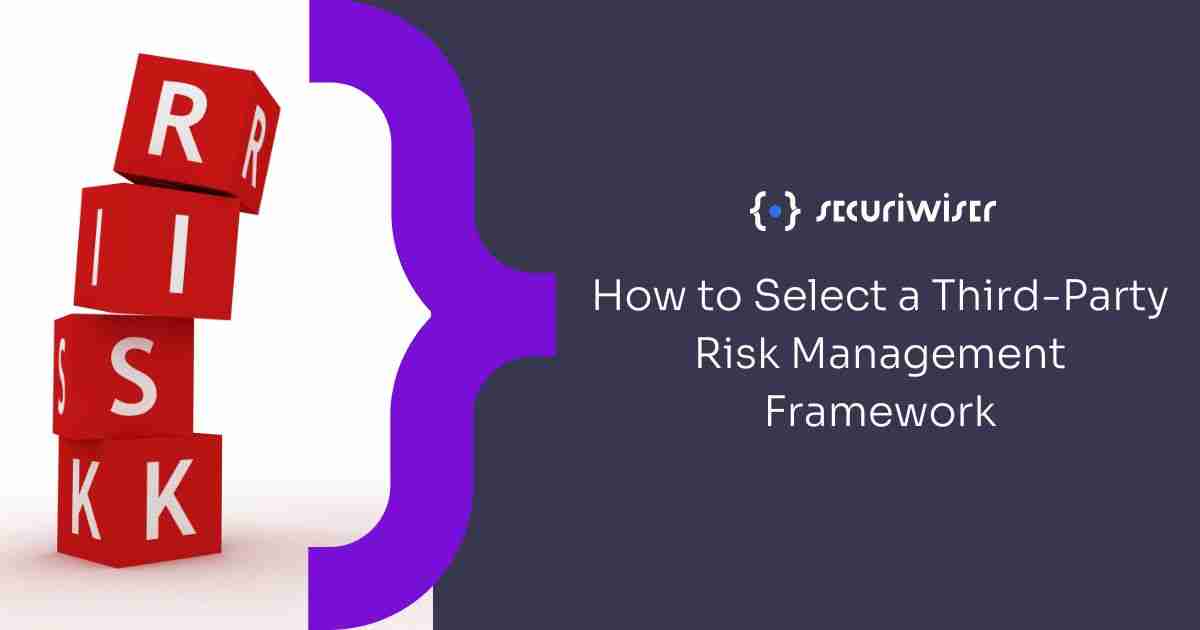How to Select a Third Party Risk Management Framework
Blog / How to Select a Third Party Risk Management Framework
4 MIN READ


As organisations in the UK continue to expand their reliance on third-party vendors, it is becoming increasingly important for them to effectively manage the associated risks. In the financial services sector, the need for robust third-party risk management is heightened by the increasing regulatory focus and complexity of relationships with both foreign and domestic third-parties.
While outsourcing can provide strategic advantages to organisations, it is important to recognise that it also presents cyber security risks. As organisations grow in size and complexity, managing these relationships becomes increasingly critical to success. Those who are unable to effectively manage third-party risks may find themselves at a disadvantage compared to organisations who are able to confidently identify and mitigate these risks.
Regardless of regulatory requirements, it is advisable for all organisations in the UK to institute a third-party risk management plan as part of their security risk management processes. This includes even extending to fourth-party management in order to effectively mitigate digital risks.
What is Third-Party Risk Management (TPRM)?
Third-party risk management (TPRM) involves the systematic examination and control of risks associated with outsourcing to third-party vendors or service providers. This encompasses evaluating potential threats to the organisation's intellectual property, data, operations, finances, customer information, and other sensitive information.
As a result, due diligence must be exercised to assess the overall suitability of a third-party for a specific task, and to verify that they have the capability to maintain the confidentiality of sensitive information.
Due diligence refers to the comprehensive evaluation of a third-party, carried out to determine its suitability for a given task. This is a continuous process that encompasses review, monitoring, and ongoing communication throughout the vendor's lifecycle.
The objective of any third-party risk management program is to reduce the incidence of data breaches, minimise operational disruptions, guard against vendor bankruptcy, and comply with regulatory requirements. Although managing third-party risk is not a novel concept, the level of risk being taken on has increased.
Organisations now face new and evolving risks, such as the possibility of high-profile business failures, the attribution of illegal actions taken by third-parties to the organisation, and regulatory enforcement for actions taken by third-party vendors.
Why Do I Need a Third-Party Risk Management Framework?
It is imperative for organisations to have a comprehensive and well-established third-party risk management program that covers all aspects of risk and encompasses all phases of the third-party relationship lifecycle, from initial due diligence to business continuity.
A narrow focus on operational risk factors such as performance, quality standards, delivery times, KPIs, and SLA measurement is insufficient. Reputational and financial risks, such as labour practices, information risk management, and financial stability, have become increasingly significant.
Organisations must also be aware of legal and regulatory requirements, including compliance with anti-bribery regulations, familiarity with relevant global industry standards, and adherence to environmental and health and safety regulations.
Senior management must recognise the elevated risk of cyber security attacks and data breaches posed by both the organisation and its third and fourth-party service providers. Regardless of the organisation's risk profile, the implementation of a third-party risk management process is a critical component of internal audit and risk mitigation.
The risk assessment process should be integrated into the organisation's internal controls and encompass assessments of the supply chain and other third-party relationships.
Third-parties encompass vendors, suppliers, business partners, marketing affiliates, payroll providers, and any other entities that could result in financial, regulatory, or reputational harm in the event of a breach.
How Do I Select a Third-Party Risk Management Framework?
The selection of a third-party risk management framework should be based on the organisation's regulatory obligations, acceptable level of risk, utilisation of third-parties, business operations, joint ventures, compliance needs, and overall enterprise risk management strategy.
Organisations are increasingly incorporating third-parties into their supply chain and utilising auxiliary services such as sales, distribution, and support. The growing adoption of technologies, such as cloud computing and cloud-based applications, has amplified the trend towards outsourcing and correspondingly elevated associated risks.
Moreover, the tasks being executed by third-parties are of increasing value, which amplifies the potential impact of disruption or failure of these vendors.
Third-party risk management is a key issue on the agendas of in many organisations, particularly those operating in regulated industries. On-site assessments of third-party facilities have become more widespread as a means of ensuring third-party management practices.
As businesses become more decentralised, there is an increasing need for uniform third-party governance frameworks. Leading organisations are effectively managing the risks associated with their extensive use of third-parties.
Is My Organisation Liable for Third-Party Breaches?
In the UK, businesses can be held liable for the security failures of their third-party providers. Understanding your liability and the steps you can take to mitigate it will help protect your business from legal and financial repercussions.
The UK Data Protection Act 2018 sets out the rules for data protection and data privacy in the UK. It states that data controllers - the organisations that determine why and how personal data is processed - are responsible for any breaches caused by third-party providers. This means that businesses must take care to ensure their third-party providers are compliant with the Data Protection Act 2018.
Best Practices for a Third-Party Risk Management Framework?
When looking for a third-party provider, businesses should consider the provider's security measures and its contractual obligations towards the business. The contract should include provisions that specify the provider's security obligations and the responsibilities of both parties in the event of a breach. The contract should also provide for the right of the business to audit the provider's security practices.
To reduce the risk of a third-party breach, businesses should also consider the data they are sharing with third-party providers. Businesses should limit the data they provide to what is necessary for the third-party provider to do its job and should ensure that the data is encrypted and secure.
Finally, businesses should have a plan in place for dealing with a breach in the event that one does occur. This should include measures for notifying affected customers and providing them with appropriate remedies. It should also include steps for mitigating the damage caused by the breach.
By taking the necessary steps to protect their business from third-party breaches, businesses can ensure that they comply with the UK Data Protection Act 2018 and reduce the risk of legal and financial repercussions. With the right preparation and awareness, businesses can protect themselves and their customers from the risks posed by third-party providers.
In conclusion, third-party risk management is essential for organisations in the UK to ensure that they are able to manage their cyber security risks and meet legal requirements. A comprehensive risk management program should encompass all phases of the third-party relationship lifecycle, from initial due diligence to business continuity.
Organisations should limit the data they share with third-party providers and have a plan in place for responding to a potential breach. By taking the necessary steps, organisations can protect themselves and their customers from the risks posed by third-party providers.
Sign up for a free Securiwiser account today to learn more about third-party risk management and how you can protect your organisation.
Previous Article
Meeting digital and technology standards in schools and collegesNext Article
Why is Cyber Resilience Important?How secure is
your business?
Blog categories
How secure is
your business?